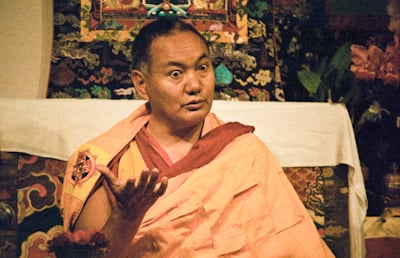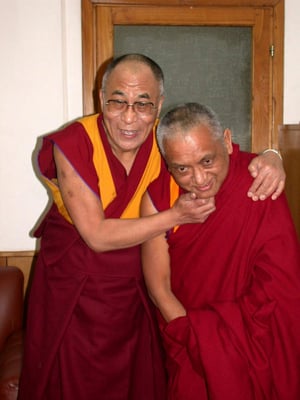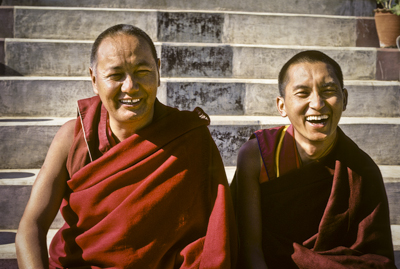Dear Friends,
Thanks again for taking the time to read our monthly e-letter. And again, please share it far and wide…the more people read it the better!
 We’re happy to announce further additions to the audio section of our Web site: Lama Yeshe’s teaching titled Anxiety in the Nuclear Age, and Lama chanting the Chöd sadhana. Check them out.
We’re happy to announce further additions to the audio section of our Web site: Lama Yeshe’s teaching titled Anxiety in the Nuclear Age, and Lama chanting the Chöd sadhana. Check them out.
We’ve posted some new transcripts as well: Lama Zopa's extensive commentary on the Ganden Lha Gyäma (Guru Yoga of Je Tsongkhapa); a new section for Lama Tsongkhapa which includes a biography and three of his texts; and Pabongka Rinpoche’s How to Meditate on the Stages of the Path to Enlightenment which Rinpoche refers to in his teaching below.
Also, I’d like to remind you to look at the Lama Zopa Rinpoche advice book, which we told you about last time. We’ve added more pieces of advice and will continue to do so. One of our readers just wrote:
Yesterday morning, I read a newspaper article which was about how more people were having many partners at the same time. After I read this, I immediately started experiencing depression. I remembered reading what Lama Zopa Rinpoche said, that depression is caused by the karma of sexual misconduct.
So maybe this newspaper article about sexual misconduct was the outer condition which caused my inner bad karma of sexual misconduct to ripen, and I experienced depression. So this depression went on today, until I tried to generate good motivation and did tonglen, wishing to take on the depression of everybody else and giving them my merits. So that just dispelled all the depression I was having, and now I feel very positive and happy, no trace of depression.
So I am very grateful that you have Lama Zopa Rinpoche's advice on your website, through which I was saved from experiencing more suffering of depression. If I hadn't done something about it, it might well have gone on for a long time.
Anyway, that's just a positive experience from the last two days. I hope many others benefit from your website as well.
So, there’s a recommendation for both reading Lama Zopa Rinpoche’s advice and practicing Dharma—especially tonglen—as a solution to life’s problems!
Last year I told you how my experience of investigating the PETA Web site shocked me into vegetarianism. Many of you responded very positively and I thank you for those responses. I had another look at it the other day (I must confess it’s too depressing to look at regularly) and saw the horror of the lives of monkeys used in medical experiments and the dreadful suffering of animals skinned alive for their fur. It’s all a sobering reminder of the nature of samsara and a huge encouragement to develop compassion for less fortunate sentient beings and practice Dharma for their enlightenment and liberation from suffering. And all this can only be reinforced by Lama Zopa Rinpoche’s teaching, below, on the kindness of all sentient beings.
I haven’t mentioned our membership plan for a while but I would encourage you to take a look and, if you haven’t yet, please join up if you can. This would help our mission a lot. Thank you so much.
 And by the time you’re reading this, I should be in Dharamsala for His Holiness the Dalai Lama’s teachings on the Four Interwoven Annotations, a commentary on Lama Tsongkhapa’s Lamrim Chenmo created by weaving together four different lamas’ margin notes to this great text. I understand that His Holiness rarely, if ever, teaches this text, so my wife, Wendy Cook, director of Kurukulla Center, and I decided to accompany our kind Geshe Tsulga, the Center’s resident teacher, to India not only for the teachings but also to join with our Tibetan brothers and sisters in celebrating His Holiness’s seventieth birthday July 6.
And by the time you’re reading this, I should be in Dharamsala for His Holiness the Dalai Lama’s teachings on the Four Interwoven Annotations, a commentary on Lama Tsongkhapa’s Lamrim Chenmo created by weaving together four different lamas’ margin notes to this great text. I understand that His Holiness rarely, if ever, teaches this text, so my wife, Wendy Cook, director of Kurukulla Center, and I decided to accompany our kind Geshe Tsulga, the Center’s resident teacher, to India not only for the teachings but also to join with our Tibetan brothers and sisters in celebrating His Holiness’s seventieth birthday July 6.
If you are interested in reading an English translation of at least part of this text, you can find a copy of it in Betsy Napper’s Dependent Arising and Emptiness, pp. 219–400, published by Wisdom Publications.
Speaking of His Holiness’s seventieth birthday, the Australia Tibet Council (ATC) is preparing a special birthday card which will be presented to His Holiness in Dharamsala just before his birthday. You can include your name and a message by signing up at www.atc.org.au. ATC will send out an email with a photo of the presentation, and if you’d rather not be subscribed to their list afterwards it’s easy to unsubscribe.
So, until the July e-letter, thank you so much for your interest in and support of the Lama Yeshe Wisdom Archive. We couldn’t do it without you!
Much love,
Nick Ribush
Director
Practicing Lam-Rim in Daily Life
(Continued from the April e-letter)
One of the messages I wanted to put on my car was, “Whenever you see anybody, think, ‘This is my wish-fulfilling jewel.’”
This is an excellent practice for your daily life. One of the ways of making your life meaningful is to meditate on bodhicitta in the morning, especially on the seven techniques of Mahayana cause and effect, where you recognize all sentient beings as your mother and remember their kindness. So you do this meditation in the morning and then during the rest of the day practice mindfulness of that; whenever you see any other sentient being—human or animal—think, “This is my mother; how kind.” Recognize that every sentient being you see has been your mother and recall the mother’s kindness she showed you at that time.
In the morning, generate bodhicitta by meditating on the extensive kindness of sentient beings, the shortcomings of the self-cherishing thought, the benefit of cherishing others and exchanging yourself for others, then the rest of the day keep your mind in bodhicitta continuously by remembering the mother’s kindness whenever you see any other sentient being. In that way you make your life meaningful; you begin your day with bodhicitta and then live your life in it.
By practicing in this way, whenever you see any other beings you naturally and automatically feel in your mind that they’re precious, cherish them, and show kindness and respect.
 When you practice bodhicitta continuously in this way you are constantly extracting the essence from your perfect human body, making your perfect human rebirth most highly meaningful. Whatever you do is naturally dedicated for others, is work for others. Then, no matter what happens during the rest of the day, how busy you are, while your mind is in bodhicitta, while you are practicing mindfulness of bodhicitta, all your activities—walking, sitting, sleeping and so forth, everything—are done for the sake of others. This produces incredible joy and happiness in your mind, a deep feeling of fulfillment and satisfaction in your heart. Your life becomes very satisfying, very happy, very joyful and not at all self-centered.
When you practice bodhicitta continuously in this way you are constantly extracting the essence from your perfect human body, making your perfect human rebirth most highly meaningful. Whatever you do is naturally dedicated for others, is work for others. Then, no matter what happens during the rest of the day, how busy you are, while your mind is in bodhicitta, while you are practicing mindfulness of bodhicitta, all your activities—walking, sitting, sleeping and so forth, everything—are done for the sake of others. This produces incredible joy and happiness in your mind, a deep feeling of fulfillment and satisfaction in your heart. Your life becomes very satisfying, very happy, very joyful and not at all self-centered.
Normally, when you’re walking down the street and look at people who are self-centered, thinking only of their own happiness, their own problems, and completely absorbed in their own lives, you’ll see that their faces are sad and unhappy and that it wouldn’t take much them to get angry and disturbed. You can see this from their faces. When you’re always thinking of your own problems, your own happiness—“When will I be happy? When will I be happy?”—there’s no smile, no peace or tranquility, no look of happiness—only a sad and disturbed appearance, and when others see you it doesn’t have a positive effect; it only causes them to feel unhappy.
So that’s the effect of always thinking of your own happiness, cherishing the I and being self-centered: it’s only negative. Even your physical appearance becomes unpleasant. But when you keep your mind in bodhicitta—the determination to reach enlightenment for the sake of all sentient beings—there’s much peace, joy and tranquility in your life, you look happy, there’s always a smile on your face and that makes others happy.
Each wish-fulfilling sentient being is more precious than a sky-full of wish-fulfilling jewels. Sentient beings are most precious, most kind, and there’s nothing in your life to cherish more than other sentient beings, nobody else to work for other than sentient beings. What they want is happiness and what they do not want is suffering, so the full responsibility of each of us is to free every sentient being from suffering and its cause and bring them to enlightenment, by oneself alone.
In order to do this we first need to attain enlightenment ourselves, to achieve the omniscient mind that sees all sentient beings directly. Then we can read sentient beings’ individual minds, see all their characteristics, levels of mind and karma, and know all the methods that will suit even one sentient being’s mind to lead that being from happiness to happiness to full enlightenment.
To reach enlightenment ourselves we need to actualize the path, which doesn’t happen without cause and conditions. That is, we need to actualize the steps of the path to enlightenment, to follow the graduated path to enlightenment. That’s the only way to complete the path, and to bring realizations, it has to be practiced in the right order.
Just meditating on the bits you like and avoiding the bits you don’t—like the sufferings of the three lower realms, impermanence and death and the suffering nature of samsara and life—not thinking about or meditating on them, not putting them into practice, and focusing only on the parts that sound good, you can’t really achieve any realizations.
Without meditating on samsara as only in the nature of suffering, without feeling as if you’re caught in a fire, trapped in a tank of raw sewage or sitting naked in a thorn bush, you can’t develop total aversion to samsara or renunciation of it. Without that, you can’t realize compassion for other sentient beings or bodhicitta and therefore can’t enter the Mahayana path. In other words, you have to achieve the realizations of the graduated path to enlightenment.
To know how to meditate on the lamrim in everyday life, Pabongka Dechen Nyingpo’s practical advice, How to Meditate on the Stages of the Path to Enlightenment, is invaluable because it comes from his own personal experience of having completed the path to enlightenment.
To be continued in the July e-letter.
Lama Zopa Rinpoche gave this teaching at the Mahamudra Retreat, Adelaide, Australia, April 2004. It was excerpted and edited from the Lama Yeshe Wisdom Archive by Nicholas Ribush. Excerpts of the teachings from this retreat can be listened to on the audio section of our website—see Day 23 for this teaching.































